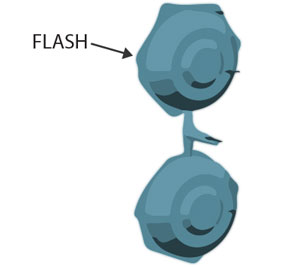Flash is one of the most common defects in the injection molding industry. In the production of injection molded parts, the first process after demolding is to manually scrape off the flash, which will undoubtedly reduce the productivity and directly affect the appearance quality of the plastic part. In the plastic injection molding process, because the mold is subjected to the complex influence of various external factors, it often causes the distortion of the molded product. The most common manifestation of this distortion is the flash caused by the plastic overflow. In this article, we discuss about the causes for flash in injection molding and the methods for fixing flash in injection molding.

What Causes Flash In Injection Molded Parts & How To Fix Them
Equipment
1. The real clamping force of the machine is insufficient. When selecting the injection molding machine, the rated clamping force of the machine must be higher than the tension formed by the longitudinal projection area of the injection molding product during injection, otherwise, the die will expand and flash.
2. The adjustment of the mold closing device is not good, the elbow bar mechanism is not straight, resulting in uneven mold closing or left and right or up and down, and the mold parallelism can not reach the phenomenon, resulting in the situation that one side of the mold is closed tightly while the other side is not close, and there will be flash during injection.
3. The poor parallelism of the die itself, or the installation is not parallel, or the template is not parallel, or the force distribution and deformation of the pull rod are uneven, which will cause the die closing not tight and produce flash.
4. Serious wear of check ring, failure of spring nozzle spring, excessive wear of barrel or screw, failure of cooling system at feed inlet, insufficient feeding amount of barrel, and too small cushion may cause repeated flash. Therefore, it is necessary to repair or replace accessories in time.
Mould
1.The uneven distribution of die cavity or insufficient parallelism will result in local flash and local dissatisfaction. Under the premise of not affecting the integrity of the part, the runner should be placed in the center of mass symmetry as far as possible.
2.The flash will be caused when the force of moving component and sliding core is unbalanced.
3.When the mold is not well vented, the compressed air will make the parting surface of the mold expand and flash. Therefore, it is necessary to set up a good exhaust system or dig an exhaust ditch on the parting surface.
Process
1. The injection pressure is too high or the injection speed is too fast. Due to high pressure and high speed, the opening force on the mold increases, resulting in overflow. The injection speed and injection time should be adjusted according to the thickness of the products. The thin products should be filled with high speed and fast, and no injection should be made after filling; the thick products should be filled with low speed and the skin should be fixed before the final pressure is reached.
2. Excessive feeding amount causes flash. It should be noted that too much molten material should not be injected in order to prevent the depression, so that the depression may not be “filled in”, but the flash will appear. This situation should be solved by prolonging injection time or holding pressure time.
3. Too high temperature of barrel and nozzle or too high temperature of mold will reduce the viscosity of plastic, increase the fluidity, and cause flash in the case of smooth injection.
Raw Materials
1. Flash may occur if the viscosity of plastic is too high or too low.
2. When the particle size of plastic raw material is not uniform, the feeding amount will change indefinitely, and the parts may be dissatisfied or flash.
3. If the fluidity of plastics is too large or too much lubricant is added, the pressure, speed and temperature should be appropriately reduced to reduce the amount of lubricant used. If necessary, plastics with low fluidity should be selected.
